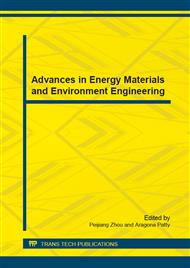[1]
YingXue Sun, QianYuan Wu, HongYingHu, et al., J. Hazardous Mat. 168 (2009), p.1290–1295.
Google Scholar
[2]
Singer P.C., J. Environ. Eng. 120 (1994), p.727–744.
Google Scholar
[3]
Muellner, M.G., Wagner, E.D., Mccalla, K., et al., Environ. Sci. Technol. 41 (2007), p.645–651.
Google Scholar
[4]
H. Komulainen, Toxicology 198 (2004), pp.239-248.
Google Scholar
[5]
Singer, P.C., J. Am. Water Works Assoc. 98(2006), p.73–80.
Google Scholar
[6]
L. Zhang, L. Xu, Q. Zeng, et al., Mutat. Res. 741 (2012), p.89–94.
Google Scholar
[7]
WHO. Environmental health criteria 216: disinfectants and disinfectant by-products. Geneva: World Health Organization, (2000).
Google Scholar
[8]
USEPA, Guidelines for Water Reuse, U.S. Environmental Protection Agency, Washington DC, (2004).
Google Scholar
[9]
Huachang Hong, Yujing Xiong, Mengyong Ruan, et al., Science of the Total Environment 444 (2013), p.196–204.
Google Scholar
[10]
G.H.R. Silva, L.A. Daniel, H. Buring, et al., Bioresource Technol 101 (2010), pp.6981-6986.
Google Scholar
[11]
V. Camel and A. Bermond, Wat. Res. 32 (1998), p.3208–3222.
Google Scholar
[12]
Arzu Teksoy, Ufuk Alkan, Huseyin Savas., et al., Separation and Purification Technol. 61 (2008), p.447–454.
Google Scholar
[13]
Guay C, Rodriguez M, S'erodes J., Desalination 176 (2005), p.229–240.
Google Scholar
[14]
G.L. Amy, L. Tan, M.L. Davis, Wat. Res. 25 (1991), p.191–202.
Google Scholar
[15]
Huang Jianjun and Zhang Zhaohui, Study on control of Trihalomethane Formation potential in Ozonation-Biofiltration process. In: International Conference on Energy and Environment Technology (ICEET), Guilin, (2009).
DOI: 10.1109/iceet.2009.598
Google Scholar
[16]
Shuqing Zhao, Zhonglin Chen, Xu Zhai, et al., Comparison of chlorogenerated disinfection byproduct formation from sequential use ozone and monochloramine with alternative disinfection. In: International Conference on Challenges in Environmental Science and Computer Engineering (CESCE), Wuhan, (2010).
DOI: 10.1109/cesce.2010.231
Google Scholar
[17]
Baozhen Wang, Jun Yin, Jinzhi Tian, et al., Ozone Sci. Eng. 6 (1984), p.261–273.
Google Scholar
[18]
Guanghui Hua and David A. Reckhow, Wat. Res. 41 (2007), p.1667–1678.
Google Scholar
[19]
R.R. Trussell and M.D. Umphres, J. AWWA 70 (1978), p.604–602.
Google Scholar
[20]
M.S. Siddiqui, G.L. Amy, B.D. Murphy, Wat. Res. 31 (1999), p.3098–3106.
Google Scholar
[21]
Cao nan, Miao Tingting, Li Kuixiao, et al., J. Environ. Sci. 21 (2009), p.409–413.
Google Scholar
[22]
ShangchaoYue, Lejun Zhao, Xiuduo Wang, et al., Advanced Materials Research, 884-885 (2014), p.91–95.
Google Scholar
[23]
Weishaar J. L., Aiken G. R., BergamaschiB. A., et al., Environ. Sci. &Technol. 37 (2003), p.4702–4708.
Google Scholar
[24]
Junzhi Zhang, Jianwei Yu, Wei An, et al., J. Environ. Sci. 23 (2011), p.183–188.
Google Scholar
[25]
Imai D, Dabwan AHA, Kaneco S, et al., Chem. Eng. J. 148 (2009), p.336–41.
Google Scholar
[26]
Fangyuan Wang, MengyongRuan, Hongjun Lin. Sci. of the Total Environ. 475 (2014), p.23–28.
Google Scholar


